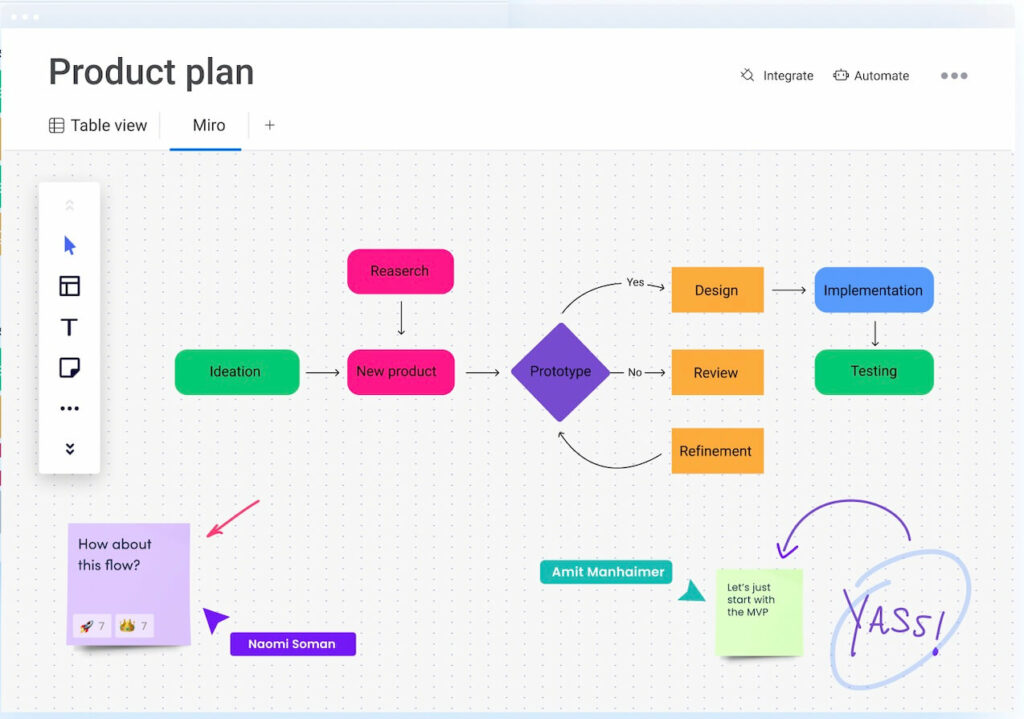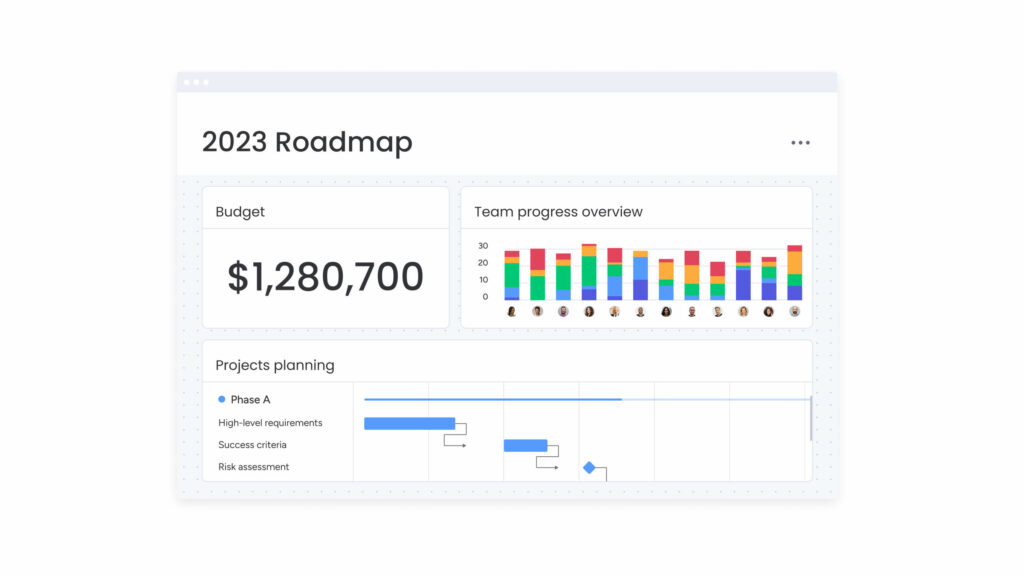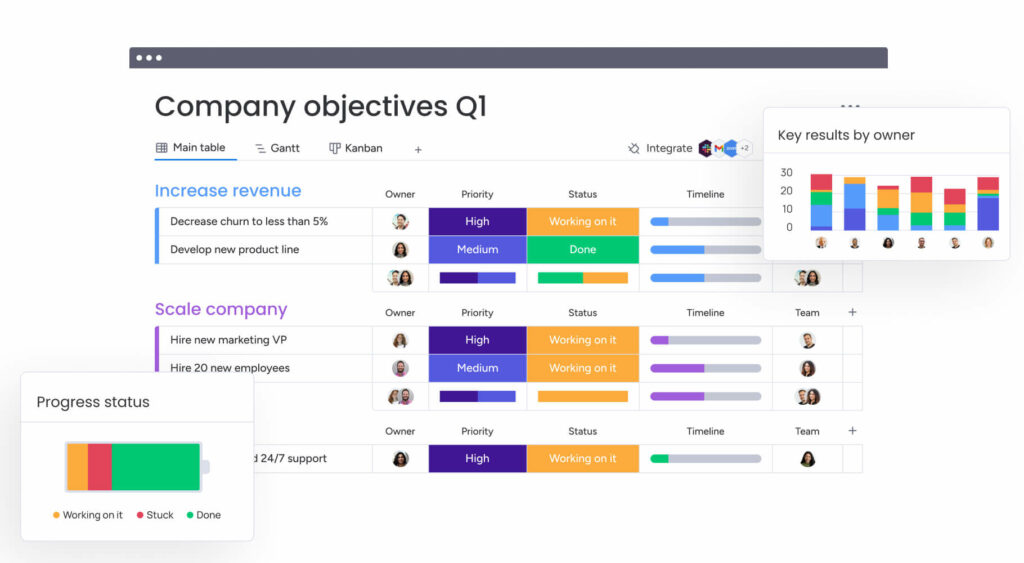
Artikel
23
januari
Product plans: Everything you need to know
If you’ve got a brilliant product idea, it can be tempting to skip the product plan. After all, product planning can feel a bit too high-level and abstract to be useful. And, in the “move fast and break things” world of product development, many teams are reluctant to slow down the time to launch with too much planning.
The problem is that, without a solid product plan, you risk missing some key steps in effective product development. For starters, you might not be building the right product. You might not all have the same product in mind. Or you might not have the right resources to build the product you want to build.
In this article, we’ll clarify what a product plan is (and what it isn’t) and why your team needs one if you’re hoping to build a successful product. Finally, we’ll touch on ways that monday dev can make your team’s product planning more effective.
What is a product plan?

A product plan is a high-level overview of the product that you’re building. A good product plan (also known as a product roadmap) captures why you’re building the product, who the product is for, how you’re going to build and launch it, and the features it needs to have before launch.
The word sometimes gets mixed up with other planning terminology, so here’s what a product plan isn’t:
Product plan vs. release plan
A product plan is not the same thing as a release plan. A product plan gives you a top-level, strategic view of the product. It includes your long-term vision for the product, your business objectives, and your product strategy.
A release plan breaks down that long-term view into specific release dates. It includes the deadlines for the milestones, features, and updates you’ll be tackling in the short term (usually the next three to six months).
In other words, a product plan will often include a release plan — but the product plan is a more comprehensive, strategic overview of the product, not just dates and deadlines.
Product plan vs. project plan
There’s also some confusion between what goes into a product plan versus a project plan. Again, there’s plenty of overlap, but a product plan doesn’t usually include an endpoint. After all, the product only “ends” when you decide not to make the product anymore — and you don’t usually know from the outset when that will be!
And, of course, the term product plan is specific to product development — whereas a project plan could be for anything from updating a website to buying a new house.
Why you need a product plan
You might feel under pressure to skip the product plan, but the consensus among experienced product developers is that you do have to spend time planning before you start developing in any serious way.
“Before you embark on a long trip — or a long development project — be clear on the goals with a rough idea of the logical steps,” advises product coach Steve Johnson.
A good product plan can give you:
-
More alignment with your team
When you put together a product plan, you have to start by agreeing on the purpose and goals of the product. That means that you’re all on the same page before you start building the product, and reduces the risk of confusion and disagreement later on.
-
Lower risk of failure
With any product, there’s a real risk that you’ll pour time and effort into building a product that nobody wants. By investing time in research, strategy, and resource planning before you start work, you reduce the risk of product failure caused by a lack of product-market fit or a shortage of resources.
-
Improved communication
Building, launching, and selling a great product means bringing together different teams (Finance, Product, Marketing, Sales) with different priorities and perspectives. A product plan gives you a shared document that will create a common understanding of the reasoning behind product decisions, what the final product will look like, and the overall product goals and vision.
monday dev makes this level of communication effortless, with visual, custom dashboards to share your product plan with the rest of the team more easily.
What should be included in a product plan?

This will vary depending on the product you’re building, but most product plans include:
- Your product vision and goals — why you’re building the product and the end goal you have in mind for it
- Market analysis and research — a summary of the competitive analysis, customer research, and market research that you’ve put together before you start work on the product
- User persona(s) — a detailed description of the user (or users) of your product
- Value proposition — a summary of the unique value that your product will offer
- Core features and functionality — the main features of your product and its most important functions
- Development timeline or release plan — a breakdown of the milestones and deadlines involved in building the product
- Budget and resource needs — a summary of the estimated budget, time, and other resources that you’ll need to effectively develop the product within the development timeline
- Go-to-market strategic overview — a summary of how you’ll introduce the product to the market, including pricing, distribution, sales and marketing
- Sprint and task planning — how you’ll break all the stages of your product development down into manageable sprints
A product plan brings together a lot of information into a top-level overview of the what, why, when, and how of your product. If you’d like to use a ready-made template, you can get one for free with monday dev.
How to create a product plan in 6 steps
Here are the seven steps to bringing together all the disparate components of your product plan into a useful working product development plan:
1. Set product goals and objectives
Start by defining your product’s overarching goals and specific, measurable objectives. Decide what you aim to achieve with your product, whether it’s market share, revenue targets, or customer satisfaction metrics — and also agree on how you’ll know when you’ve reached your initial goals.
2. Conduct market research
If you want to build a product that users truly want, you’ll need to make sure you understand your target audience, competitors, and industry trends. Now’s the time to identify market gaps and opportunities that your product can capitalize on.
3. Define the product
Outline your product’s key features, functionalities, and unique value proposition. At this stage, you should articulate how your product meets customer needs and differentiates itself from existing solutions in the market.
Some teams like to use the Product Tree exercise for this step. In this innovation game, you imagine the product as a tree, with branches representing core functionalities, roots as technical requirements, and leaves as new feature ideas. Then you prune the tree — removing unnecessary complexity by trimming leaves and branches to create a minimal viable product for the initial launch.
4. Outline the product strategy
At this point, you’ll need to summarize your product strategy so that you can communicate it effectively to the rest of the team and organization. Your product strategy should be a dynamic plan that adapts to market changes. Include aspects like your user personas, value proposition, competitive analysis, and overall business objectives here.
5. Plan resources
Once you know what you’re building, it’s time to map out the resources — including budget, personnel, and technology — that you’re going to need.
For instance, monday dev, you can plan out the human resources involved and make sure you set realistic deadlines. With the Workload view, you can visualize workloads across projects, gaining high-level and granular data to see how task hours are allocated across team members. Plan for the future and adjust as you go, distributing responsibilities according to capacity.
6. Develop a market launch strategy
There’s no point in spending all this time building a great product that nobody knows about. Instead, put some thought into how you’ll promote and sell the product before you start building. Your market strategy and launch plan will probably influence your timelines, and might also affect what you decide to include in your first version of the product.
Craft a detailed plan for introducing your product to the market. Define your pricing strategy, distribution channels, and marketing initiatives. Consider pre-launch activities to generate buzz and post-launch support to sustain momentum.
3 tips for better product plans
Here are a few tips on how to get the most out of your product plan:
1. Don’t plan too much
The development team at Basecamp calls their product planning process “shaping the work” — instead of creating a strict definition of the product upfront, they define only the key elements of the product and then hand the plan over to the development team.
They’ve found that this makes the product plan “concrete enough that the teams know what to do, yet abstract enough that they have room to work out the interesting details themselves.”
2. It’s not a one-and-done process
It can be tempting to think of product planning as a one-off process, a decision-making activity that you do before you start building the product. But markets change, customer expectations evolve, and your product plan must adapt to your changing reality.
Instead of thinking of your product plan as a static document, consider the planning process as a critical part of the product development cycle. Revisit your plan often and check whether or not your assumptions about the product, market, and users have changed over time.
3. Remember that it’s a communication tool
Your product plan isn’t just a task list — it’s a way of communicating the vision and progress of your product with the rest of the organization. Your product plan needs to be visual, bring together all relevant information in the same place, and be easy to use for communication and collaboration.
Which brings us to monday dev, the latest addition to the monday.com product line. With monday dev, development teams have everything they need to launch new products in one place and, through monday.com Work OS, connect with sales, customer success, and marketing teams.
How monday dev can help you nail your product plan

If you’re ready to level up your product planning process, monday dev is a great tool to have at your disposal. With monday dev, your development team can:
- Manage your entire product roadmap in real-time, linking epics to user stories and tasks to keep everything aligned.
- Bring distributed teams together with a digital workspace designed for collaboration, annotation, planning, and tracking work.
- Balance your product team’s workload, visualize workloads across projects, gaining high-level and granular data to see how task hours are allocated across team members.
- Communicate with the rest of the organization easily, by sharing any board from your product plan internally or externally, ensuring that stakeholders, freelancers, and team members collaborate in a single easy-to-use platform.
monday dev makes the product planning experience easy — so you can focus on building great products.
What's your reaction ?
Follow us on Social Media
Some Categories
Recent posts

July 27, 2024
Nieuwe kabinetsvisie: samen sterker tegen cyberdreigingen

July 24, 2024
Navigating AI Implementation: Try these strategies to overcome resistance.

July 24, 2024
Sick Leave Policy Netherlands Guidance for HR and Entrepreneur.

July 24, 2024
CSRD Reporting: Mandatory Reporting on Corporate Sustainability.

July 24, 2024
Training Budget: Investing in Employee Development.

 Inloggen
Inloggen
 Registreren
Registreren






Comments (0)
No reviews found
Add Comment